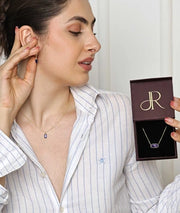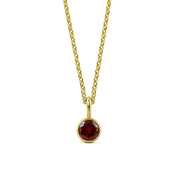Jewelry is more than an accessory; it is a reflection of your personality and style. But matching the right colors can feel tricky at times. That is where the color wheel becomes your secret styling guide. This simple tool helps you create polished, harmonious combinations with ease. Whether you are getting ready for a special occasion or planning your daily look, understanding basic color theory can make your jewelry choices feel more intentional and stylish. In this guide, we will explain how to use the color wheel for jewelry in a clear, friendly way so you can build outfits that feel balanced, bold, and completely you.
What Is Color Theory?
Also Read: How to Choose the Right Jewelry for Your Skin Tone
How to Use the Color Wheel for Jewelry Matching
The color wheel is divided into three basic categories:

-
Primary Colors: Red, blue, and yellow.
-
Secondary Colors: Green, orange, and purple (formed by mixing primary colors).
-
Tertiary Colors: Yellow-orange, red-orange, red-purple, blue-purple, blue-green, and yellow-green.
To match jewelry using the color wheel, it’s essential to understand the different color combinations you can use. Let’s explore a few common methods based on color theory.
1. Complementary Colors: Bold and Vibrant Combinations

One of the simplest ways to match jewelry is by pairing complementary colors. These are colors that sit opposite each other on the color wheel, such as blue and orange or red and green. For example, if you’re wearing a blue dress, you can complement it with jewelry that has orange tones, like copper earrings or amber necklaces. This creates a bold, striking contrast that draws attention without overwhelming the look. Jewelry color matching using complementary colors is a great way to add vibrancy and balance to your outfit.
2. Analogous Colors: Harmonious and Soft Looks
If you prefer a more subtle and harmonious look, try using analogous colors. These are colors that are next to each other on the color wheel, such as blue, green, and turquoise. For example, a turquoise bracelet paired with aqua earrings will create a soft, cohesive look that’s easy on the eyes. This combination is perfect for casual, everyday wear, or even for a more elegant event when you want to keep things understated. Analogous colors offer a peaceful, blended vibe that feels balanced without being overpowering.
Read More: How to Match Jewelry with Your Outfit: A Complete Guide
3. Triadic Colors: Balanced and Colorful Combinations
For those who love a bit of everything, triadic color schemes are a fantastic option. These colors are equally spaced around the color wheel, such as red, yellow, and blue. A triadic approach can be playful and dynamic, so if you’re wearing a yellow dress, you could pair it with blue earrings and a red ring. This combination brings color into your look in a balanced yet exciting way. Jewelry color matching using a triadic scheme adds depth and interest to your accessories while keeping them coordinated.
4. Monochromatic Colors: Chic and Minimalistic
If you prefer a minimalist style, a monochromatic color scheme might be your go-to. This involves using different shades and tints of a single color.
For example, if you’re wearing a light pink dress, you can match it with rose gold jewelry. This creates a soft, monochromatic look that’s stylish and sophisticated. Monochromatic combinations are perfect for those who like to keep their jewelry choices subtle, but still stylish.
Using Color Theory to Choose the Right Jewelry for Your Skin Tone
In addition to matching your jewelry to your outfit, color theory also helps you choose pieces that complement your skin tone. Understanding your skin’s undertones, whether cool, warm, or neutral, can guide your jewelry color matching process.

-
Cool undertones tend to look best with silver, platinum, and cool-colored stones like sapphires and emeralds.
-
Warm undertones shine with gold, rose gold, and stones like rubies, topaz, and citrine.
-
Neutral undertones can wear both gold and silver, as well as a variety of gemstones.
By considering your skin tone and applying the color wheel to jewelry, you can ensure that your accessories enhance your natural features.
Using the color wheel for jewelry helps simplify the process of pairing jewelry with outfits. Whether you want bold contrast, soft harmony, or bright mixes, a little color theory can change how you style your look. With practice, you can match your jewelry to your clothes with ease. You also learn which shades make your skin glow.
When in doubt, turn to the color wheel chart to find new ways of pairing jewelry that feels fresh and exciting. And if you're looking for elegant and unique jewelry pieces, consider exploring Rarete Jewelry, where you'll find a variety of options that work perfectly with color theory.






